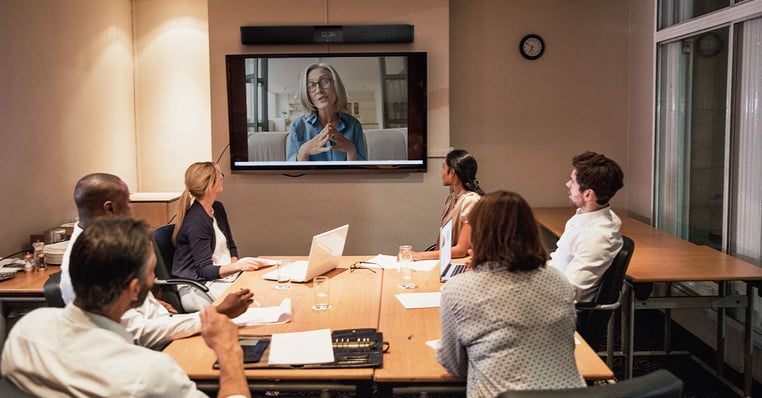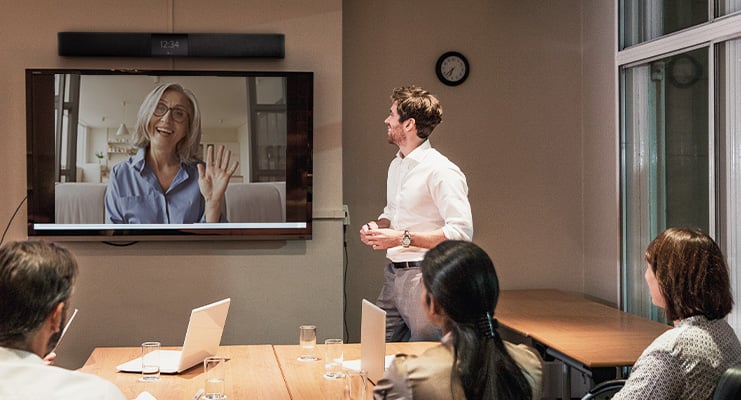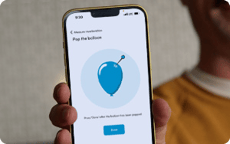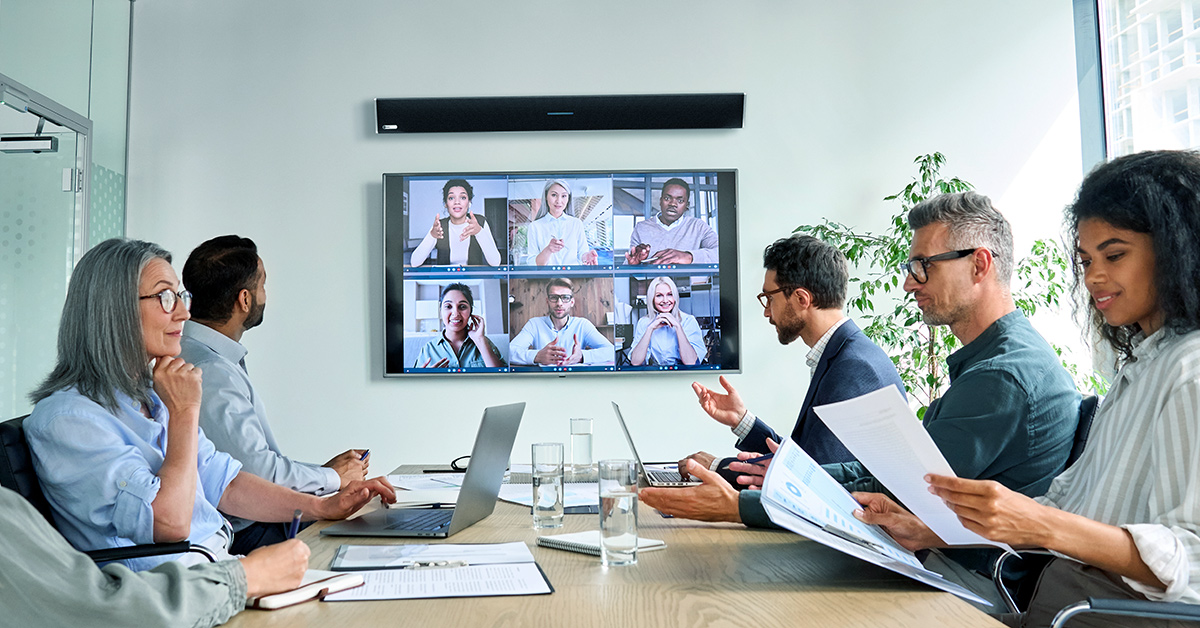How to run a better faculty meeting with remote participants

Posted by Tricia Whenham on May 5, 2022 6:00:00 AM
“Can you hear me? How about now?” “I missed what was said at the back – can you say it again?”
This is not the sound of a productive hybrid meeting. But this worst-case scenario is an understandable concern for universities and colleges that have more faculty splitting their working hours between home and campus.
Luckily, hybrid faculty, committee and other meetings don’t have to sound like this. And just as HyFlex and hybrid learning offer huge benefits to students, setting up for hybrid meeting success can help give professors and instructors the flexibility they also need to stay productive.
Hybrid meetings on your campus can be just as successful as in-person ones – but it won’t happen without deliberate effort. Here are 6 ways to improve your hybrid meetings.
1. Start inclusively
The tone set at the beginning of a hybrid meeting makes all the difference in how engaged remote people will be.
If possible, start the UC&C call a few minutes before everything officially begins so remote faculty can join in the pre-meeting conversations. For larger faculty meetings, you can try what these facilitators have called Zoom’s magic waiting room – using breakout rooms to let remote participants connect with each other in small groups first.
Also make sure you have a culture that meetings start on time, every time. The only thing worse than waiting in a meeting room is sitting on a Zoom or Teams call, wondering where everyone is. On time meetings help everyone feel valued.
For committee meetings and other smaller gatherings where participation is essential, it helps to display remote participants on a screen in the room. Even if people would rather not keep their webcams on, just having a name and avatar displayed helps those in the room remember exactly who is on the call.
2. Choose the right technology
The right equipment in your spaces makes remote participants feel like they’re in the room while reducing the distractions of technical troubleshooting for those who are in person. Your UC&C platform is only the beginning.
First, consider your audio setup. If people can’t hear clearly, nothing else will matter. Full-room microphone pickup is essential – you need to be sure the audio won’t cut out if someone turns away from a mic or moves to show something on a display. You also need audio that can handle it if everyone talks at the same time or a loud HVAC system turns on. (Here’s how we can help.)
Video also can bridge the gap between home and campus. For smaller meetings, look for options that let remote people see everyone in the room so they can follow the conversation. For larger ones, it may be more important that there’s a camera to track the presenter.
Finally, make sure the tools you use create a level playing field. For example, physical whiteboards are rarely fully legible to people joining remotely – even with a good camera. Try digital whiteboards instead, with the bonus that remote people can use them as well.
3. Get people talking
The worst-case scenario for a hybrid meeting? Probably being plagued by tech issues. But a close second is when the conversation in the room takes off and the remote people quietly disengage. If your meeting requires collaboration and communication, it helps to use tools and strategies specifically designed to keep everyone involved.
Setting up a backchannel – possibly right in your UC&C platform – gives everyone another way to participate. It can also be used for remote people to flag technical issues and get help. Everyone can use the backchannel – those in the room just need to bring their laptops.
Icebreakers have their fans and detractors, but when done judiciously, they can also get the conversation rolling. They’re particularly handy with a large group that needs to work together but doesn’t know each other well. Here are 11 icebreakers pulled from HyFlex classrooms that can also work well in hybrid meetings.

4. Invite remote participation
It can be surprisingly hard for remote people to break into the in-room conversation. The right audio and video tools help, but they aren’t always enough, especially if people are new to hybrid.
That’s why it’s better to think remote-first. Otherwise, the balance will unintentionally shift to prioritize those in the room. For example, if people are sharing updates from their departments or institutions, let the remote people go first. And if you’re soliciting feedback or input, make sure to directly ask those not in the room for their ideas.
Nonverbal cues can also be helpful in hybrid meetings, but they need to be explicit. For example, if you want to use the raise hand icon in Teams or Zoom to get the room’s attention, make sure everyone knows that’s the plan so those in the room can look out for it.
Finally, don’t underestimate the importance of silence. Just as in HyFlex classrooms, remote participants need a little more space to jump into the discussion, especially if there are connection delays. So create a culture where people in the room resist the urge to immediately fill the silence, and instead carve out space for everyone to speak.
5. Assign a facilitator
Even with the best of intentions, it’s easy to fall back into old habits. Maybe conversation in the room has gotten so animated that no one notices the remote people have gone silent.
It helps to assign an in-room facilitator who’s tasked with paying close attention to the remote experience. The person running the meeting can play this role as well, but it’s often more successful if there’s someone fully focused on remote participants.
Facilitators keep a close eye on the chat and deal with any technical issues that might come up – by troubleshooting directly or getting the right help. They notice if those in the room are dominating the conversation and invite remote people to speak. They also watch for nonverbal cues, and make sure they don’t get lost when a conversation takes off.

6. Keep improving
Great hybrid meetings will always be a work in progress. Remembering to ask for feedback periodically lets you make small adjustments as needed. Whether the issue is with meeting technology or meeting culture, problems are usually easier to attack early rather than waiting for them to fester.
Empathy can also be a strong motivator to improve the hybrid experience. Few things are more meaningful than encouraging everyone to occasionally attend a meeting remotely. This makes it much easier for those who are full time on campus to take action during meetings to make sure that hybrid experience is working for everyone.
Great audio, simplified
Are hybrid meetings becoming more frequent? Clear, reliable audio – that’s also easy and affordable – is more important than ever. Find out how our groundbreaking technology delivers the simplicity and value you need for more effective meetings.

Posted by
Tricia Whenham
May 5, 2022
















